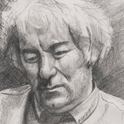The whole point about cinema, surely, is the close-up of the human face. Huge images such as the Sphinx, Mount Rushmore and the colossal statues in Greece and Rome established the sense of wonder to be had in gazing at magnified physiognomy, but until the movies, such depictions were rare. Even in vast paintings - of battles, landscapes, coronations - the human beings tended to be no more than twice or thrice our size. But Greta Garbo's inscrutable face was hundreds of times bigger than that of those who read their own thoughts into it. Therein lies the wonder of the movies.
It is perhaps surprising, therefore, that cinema is currently undergoing a flight from close-ups. It does this every now and again, as if bored with the effortless way in which macro-imagery can enrapture. Instead of bringing the camera close, as Alfred Hitchcock did in Vertigo, Nicholas Ray did in Johnny Guitar, Sergei Eisenstein did in Battleship Potemkin, Ingmar Bergman did in Persona and Carl Theodor Dreyer did in The Passion of Joan of Arc, movies today are retreating to the apparent splendours of the wide shot, the panorama, the spectacular vista intended to make us say "wow." This was the Lord of the Rings trilogy's technique, and is that of the Brad Pitt-starring Troy, and the eco-disaster picture The Day After Tomorrow. The forthcoming Boudicca movies and the Alexander the Great biopics in the pipeline - Baz Luhrmann's, starring Leonardo di Caprio and Oliver Stone's, starring Colin Farrell - are likely to do the same, and even that barometer of US cinema's artistic ambitions, Martin Scorsese, has been framing more widely recently, as Gangs of New York showed.
This trend towards wide shots is in part explained by the landmark technological changes which cinema is undergoing. Those who doubt that the digital revolution is significant should consider the fact that the two previous occasions on which film "went wide" and turned to stories set in classical times were the 1950s - after the switch to the various widescreen processes such as CinemaScope - and the very first decades of filmmaking, when audiences were still agog and directors such as Cecil B DeMille presented frieze-like tableaux of classical excess. Both were formative moments, and so is the present one. In each of these three periods, producers and directors who were faced with a new technology fell back on primitive, likeable, pre-cinematic ideas of showmanship. At times of great change in cinema, it seems, the movie world abandons its unique selling point, the close-up, to impress audiences in more conventional ways. In retrospect, Titanic - still the most commercially successful film ever made - was e-cinema's declaration of intent.
What makes me approach multiplexes with a heavy heart these days is that every filmmaker wants a go at computer generated imagery (CGI). I like landscape and cityscape cinema, but the current tableau filmmaking is a digression. The moment when it dawned on big budget directors that the computerisation of the movie process meant that they could show all those things they couldn't show before was probably an exciting one in Hollywood. Loads of dinosaur/cyborg/city-destruction movies were submitted and green-lighted. But as is often the case with adrenalin rushes and creative stampedes, good old-fashioned inventiveness got lost in the process. For those of us on the receiving end of the movies which resulted, there was a limit to the number of times we could gasp at a flyover of the Colosseum, or at vast marauding armies or the (unconvincingly weightless) destruction of one of the world's famous buildings.
In the current rejection of the close-up in mainstream cinema, filmmakers seem to have learnt nothing from the past. The 1950s epics now seem stolid, and most of DeMille is unwatchable. In a few years' time, The Phantom Menace, George Lucas's first Star Wars prequel - which was filmed almost entirely in medium and wide shot - will look like one of the most boring movies ever made. Entranced by his ability to show Hieronymus Bosch-like scenes of myriad complexity, why would Lucas do anything as boring as bring the camera close to the faces of his actors? Future audiences will be un-impressed by such CGI showreeling and will be perplexed by the film's lack of foreground. What made the Matrix films visually interesting, despite their sonorous verbal gobbledygook, is that the Wachowski brothers cast a wide range of facial types, lit them from above to emphasise the texture of each and then photographed them so that they filled the screen.
What, then, of the most talented directors at work today? How have they responded to the new possibilities of digital filming? One of the best, Iran's Abbas Kiarostami, made his first significant digital film, Ten, two years ago. His budget was far lower than Lucas's, of course, but his technique was nonetheless remarkable. He made a film in which every shot except one was a close-up. Just as Hitchcock, Dreyer and Eisenstein in their bravest, most driven projects reached for cinema's unique selling point so, in Ten, did Kiarostami.
When cinema next reinvents itself, that will be the lesson to remember.











